Monday, 29 June 2009
Too Much Puppy Food?
 Can I feed my puppy to much?
Can I feed my puppy to much?
There is a false idea with large-breed puppies that since they have larger bones, they need more calcium and more calories to continue developing at the rapid growth rate puppies experience. This is not true. Many large-breed puppies that experience too rapid of growth in their first six months experience developmental bone problems. The best plan of attack to prevent these issues in your large breed puppy is to control the rate of growth by controlling their intake of calories, calcium, and phosphorous.
If you are overfeeding your puppy, their high weight makes them at even higher risk for bone problems. You should be able to feel the dog’s ribs, but not see them. If you can not feel your puppy’s ribs, this is an indicator that you are over-feeding or should switch to a lower calorie diet. Many puppy foods are rich in calories; which is why many kennels switch to adult dog food at around 12 weeks to safely promote growth. If you feel your puppy is ready to make the switch, make sure you are feeding an adult dog food appropriate for all life stages. Follow these guidelines and your puppy will experience normal skeletal development.
Monday, 8 June 2009
Stopping a Jumping Dog
Unless given a command to jump, a dog should never be allowed to jump on humans. A dog who jumps on a human at his own free will is a dog who does not respect the person he is jumping on. Even those cute little toy dogs should not be allowed to jump on people. While you, the owner, may think it is cute, it is not cute to everyone else. Not only is it annoying to most people to have someone else's dog jump on them, it can also be dangerous. A jumping dog can knock people over and muddy their clothes, put runners in nylons and scratch.
When a dog jumps on a human at their own free will they are not "greeting" the human, they are asserting their dominance on them. It is the dog communicating that he is alpha and or wishes to own or control the human. A subordinate would never dream of running over and jumping on the alpha dog of the pack. Space is respect and lower remembers of the pack respect the higher members. If your dog jumps on humans he does not respect them.
I remember going to a dog park where a little 4 month old Boxer puppy ran around and jumped up on everyone. The dog was not heavy enough to knock most of the adults down, however, he left everyone with muddy pants and was big enough to knock over small children. The owner did nothing to stop the jumping puppy. After all, it was just a small pup. Everyone around her was pretty annoyed at the muddy prints the dog was leaving all over their clothes. That is an owner who will have a problem with their dog jumping on people when he gets older.
Puppies should be told from day one, "no jumping". Anything you do not wish your cute little puppy to do when he is full grown should not be allowed when he is a puppy. Think about the behaviors you allow your puppy to do; is it something you will always allow him to do even when he is full grown? If the answer is no, do not allow your puppy to do it from day one.
Dogs like and need consistency, so if you are not allowing your dog to jump on you, everyone in the family and everyone who greets the dog must do the same. You, as an owner, must make sure this happens. It will only confuse a dog if you allow him to jump on some people who say they do not mind, and tell him not to jump on others. Once you decide you do not wish your dog to jump on people you must apply this to everyone at all times unless you give the dog a command to jump. A dog should never jump on a human at his own free will.
Stopping the Jumps
To a dog, space and balance is very important. If you take a step backwards or lean out of a jumping dogs way, the dog will continue to jump. To a dog, space means a lot and the dog will be gaining space. When a dog jumps, step into "your space". Picture a sphere around you. A sphere of your space and you are not going to allow anyone or anything to come into your space. When the dog jumps, step into it sideways with your body, shoulder towards the dog. Don't face the dog head on. You are not trying to knock the dog down, you are simply calmly filling up your space with your body, and in return, setting the dog off balance, which is an uncomfortable feeling for a dog. Lean slightly forward, not backward. Never lean backwards, as you will be giving the dog that space. Casually and calmly, keep filling your space, not allowing room for the dog to come in. Remember, your goal is not to knock the dog down or walk into the dog, it's just to fill your space. You may end up bumping into the dog in doing so, however, do not make that your goal, keep the goal on protecting your space.
You can do this with any dog who jumps on you, take a sideways step forward just as the dog starts to jump, filling the space the dog was about to take up. This will throw off the dogs balance and at the same time, claim your space. You will earn respect from the dog and soon, the dog will learn it is no fun to jump on you.
© Dog Breed Info Center® All Rights Reserved
Recognizing Dominate Behaviors in Dogs
List of dominate behaviors which can occur in dogs (This list is not yet complete)
Besides the obvious guarding, growling and biting many dogs display a variety of dominant behaviors that commonly go unrecognized by their humans. Dogs very rarely display the highest level of dominance overnight. There are usually signs leading up to it over the years and dominate alpha dogs do not always growl and bite. If the owners are giving the dog what they want there sometimes is no reason for the dog to growl or bite unless they are challenged. Dogs understand that they exist in a human world. After all, who gives them food and opens the door for them to go potty? When humans perform these tasks on demand from the dog though, why wouldn't the dog think they're the leader? It is easy for dogs to get the impression they are alpha in their pack. Since many canine alpha behaviors are not acceptable in human society, for example biting being one of the alpha communication tactics it is important for humans to remain the leaders over their dogs.
Below are some common behaviors dogs display when they believe they are above humans. Keep in mind that a dog does not have to display all of these behaviors to be in a dominant frame of mind. Sometimes an alpha dog will only display a few of the behaviors and at random times, depending on what the dog decides they feel like doing at any given moment. Smarter dogs tend to challenge the pack order more then dogs of average or below average intelligence.
Stubbornness
Headstrong and willful
Demanding
Pushiness
Begging
Pushing a toy into you in order to get you to play with them.
Nudging to be pet.
Sitting in high places looking down on everything.
Barking or whining at humans which many owners consider "talking" (without a command to do so).
Jumping or putting their paws on humans (without a command to do so).
Persistence about going in and out doorways before humans.
Persistence about walking in front of humans while on a lead.
Not listening to known commands.
Dislikes people touching their food.
Standing proud on a human lap.
Persistence about being on top, be it a lap or stepping on your foot.
Persistence about where they sleep, i.e. on your pillow.
Annoyance if disturbed while sleeping.
Likes to sleep on top of their humans.
Licking (giving kisses) in a determined and focused manner.
Caring themselves with a proud gait, head held high.
Not liking to be left alone and getting overly excited upon the humans return. (See Separation Anxiety in Dogs)
To learn more about dog psychology and what makes a dog tick, we strongly suggest Cesar Millan DVD's and or Cesar Millan Books to every dog owner, from Chihuahua to Pit Bull
. An excellent guide to
Small Dogs vs. Medium and Large Dogs
(Small Dog Syndrome - Dog believes he is the pack leader to humans)
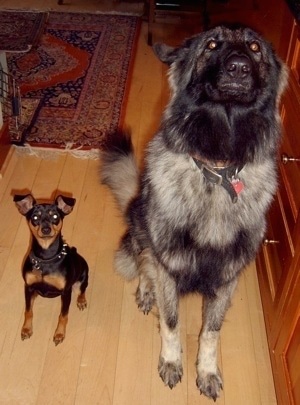
Are you one of those people who prefer larger dogs? Do you know someone who has told you that they prefer larger dogs because small dogs are yappy and snappy? Whether we are a large dog person or a small dog person, one thing we all would agree on, is the larger percentage of small dogs tend to have a different type of temperament than medium and large dogs. Small dogs have earned the reputation of being yappy, snappy, jealous, protective, wary of strangers and not the greatest child companion and, unfortunately, it has become widely accepted. Similar to the myth that Pit Bulls are all vicious fighting dogs whose jaws lock and they will not let go until their prey is dead. That's just the way some small dogs are. Right?
I received a package and my two Boxers went over to greet the UPS driver. I called the dogs back and the driver explained he didn't mind saying hello to my dogs. He could tell they were friendly, then added.... "It's those small dogs you have to watch out for."
So why do little dogs tend to act differently than large dogs? They are all the same type of animal, a mammal of the Canidae family, of the order Carnivora: Canis lupus familiaris, which is a domesticated subspecies of the wolf. Commonly referred to as a canine. This type of animal has instincts that need to be fulfilled in order for the animal to be happy and balanced. Let's take a closer look at how we treat large and medium dogs, as opposed to how we treat small and toy dogs.
Many behaviors we humans do not allow large dogs to get away with we find cute in small dogs. For example:
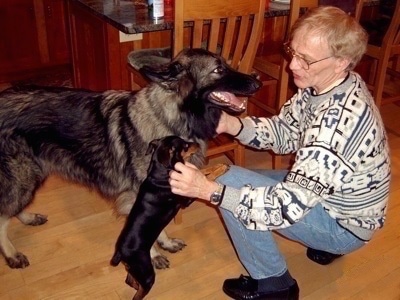
Jumping
If an 80-pound German Shepherd jumps up on a human, everyone agrees that this behavior needs to be corrected. Everyone sees this as a problem and the owners would seek help from a trainer, and/or read up on it on the Internet to remedy the behavior. At the very least, the dog would be locked in a separate room when guests arrived to protect the guests from getting hurt.
Now picture a little 8-pound Miniature Pinscher jumping up on a human. You look down and I’ll be darned, it's kind of cute. It does not hurt and people think "The dog likes me!"
But what does it really mean? If dogs were human this would be true ... but they are not. Jumping has a totally different meaning to a dog than it does a human. It's a dominancy and respect issue. For a dog, space is a sign of respect and when you allow your little dog to jump on a human you are allowing them to disrespect a human. You are allowing them to display pack leader behaviors.
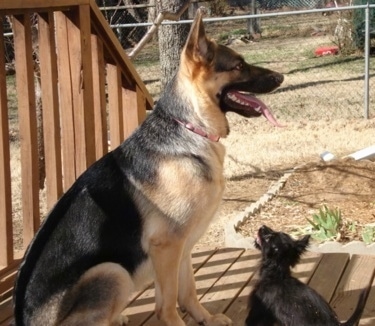
Sadie, the 70-pound GSD, with Rudy, a 4-pound Chorkie.
Growling
If a German Shepherd were to growl at your guest, you and your guest both know there is a problem. Something has to be done. However, if that tiny 6-pound Chihuahua growls, well it's just what he does. He's a Chihuahua, right? Wrong... There is no difference, in a dog’s mind, for a German Shepherd to be growling at a human than there is for a Chihuahua. It's just another behavior we humans let those tiny dogs get away with.
Other Dogs
If your little 5-pound Yorkshire Terrier decides to bark and growl at another dog while you are walking down the street, or as another dog passes by your house, it's almost seen as cute, because you see it as your tiny dog thinking they are a big dog. However, if your 120 pound Akita barks and growls at another dog, the dog is more likely to be put in their place and told to stop. The fact is, dogs should never be allowed to display dominant behaviors. Whether it be a huge or tiny dog, their pack leaders (humans) should tell the dogs "NO" and follow through until the dog understands this is not an acceptable behavior. And for the record, dogs do not "think" they are either big or little. They live in the moment and are just what they are, reacting to the moment. To dogs, size means nothing.
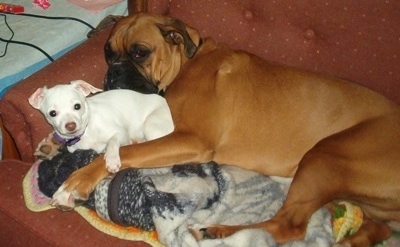
Roxanna the Boxer laying down with Miya, the Jack Chi hybrid.
Space
If you were eating dinner or working at your computer and your 70-pound Boxer comes running over and jumps up on your lap, chances are you would knock them back down telling them "No, not now, I am busy". However, if that 5-pound Maltese jumps up on your lap, well it's just cute. He loves you and just wants to be on you. There's that space issue again. Pack leaders decide when and where to do things. The pack leader belongs on top. It is ok for your little lap dog to sit on your lap. However, it has to be at times when YOU invite them.
Claiming the Human
If you are sitting down watching TV on the couch, your little dog can jump up next to you on the couch, so long as your dog understands it is your couch, not theirs. You need to make your dog wait until you invite them to climb into your lap. When a dog makes it a habit of jumping up on a human at their own free will, we humans see it as love and affection. However, to a dog it is a claim. The dog is trying to own you. So the next time you notice your dog is adamant about being on you, remember, he is claiming you not loving you. The human needs to claim their own space back and the dog must be told they can only climb on top when the human invites them.
If you feel your dog is jumping on you in an "I own you" way, it is best not to put nor knock the dog on the floor. Rather, use your fingers to bite her off (poking with enough intensity to make the dog react by moving). You need to communicate with your body language until they move off of the person by themselves. Make them move off; do not physically move the dog. When you see the dog settling down into a calm submissive state, (head down low, not making eye contact, ears back, tail relaxed and not tucked in, not rigidly high), then it is ok to invite them on you, if that is what YOU want. However, if the dog once again gets in an "I own you" stance, they need to be moved off again. Making the dog move, not by you moving the dog. The dog needs to be the one physically moving off.
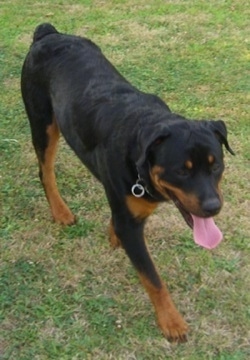
Jeremy, the Rottweiler.
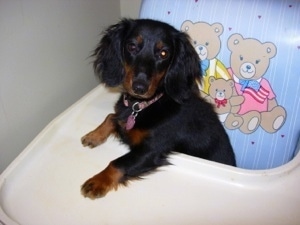
Francis, the Long Haired Miniature Dachshund.
Aggression
If your 120-pound Rottweiler decided to viciously bark at your housekeeper... you KNOW you have a problem. However, if your tiny little Dachshund does it, you inform the housekeeper to avoid the dog. The little dog may hide under the table barking and growling, is told to be quiet, but the correction is never really followed through on. The houseguest is told to not put their hands under the table. However, if this were a Rottie, the behavior would be addressed. Small dogs are more likely to be allowed to display dominant behaviors that should never be accepted.
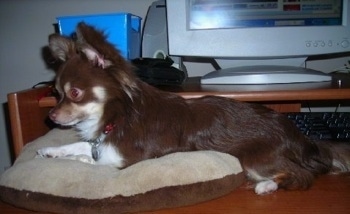
Prince, the longhaired Chihuahua.
Lap Dogs
Ever see a small dog jump up on its owners lap and growl at anyone who comes too close? The owner feels the dog is "protecting" them "because they love me". When actually the dog is "Claiming" "THEIR" property. Talk about allowing a dog to be alpha. Now imagine a Doberman Pinscher on that same person's lap, snarling if someone comes to close. Picture in your mind going back and forth, Chihuahua on their owner's lap growling... Doberman Pinscher on their owner's lap growling.
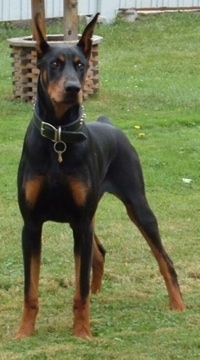
Romeo, the Doberman Pinscher.
Chihuahua, Doberman.... Chihuahua, Doberman... While it may seem less of a big deal for the Chihuahua to display this type of dominate behavior IN A DOG’S MIND there is no difference between a Chihuahua doing this and a Doberman Pinscher or German Shepherd exhibiting this behavior. Yet a large percentage of small dogs are allowed to display this behavior.
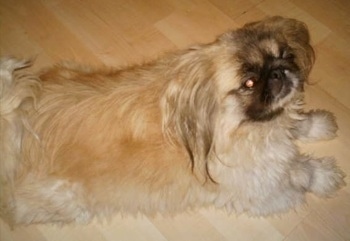
Luna, the Pekingese.
Walks
If someone were walking a 7-pound Pekingese and they were pulling on the lead as hard as they could to get near a tree to pee on it, most dog walkers would simply hold the lead and allow the dog to pull way out in front. What's the harm? The dog is not strong enough to knock a person down and you know you have a good grip on the lead, right?
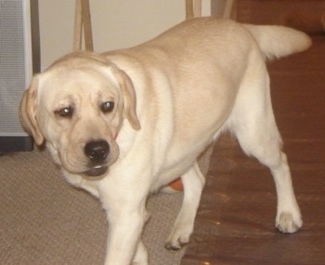
Chanel, the Labrador Retriever.
Whereas if a 70-pound Labrador Retriever were pulling you as hard as they could, there is a good chance they may just drag the human across the pavement. Large dogs are more likely to be told to behave on a lead than little dogs. However, even most large dogs do not walk properly on a lead. Most dogs (large and small) take their owners for a walk (in front of the human) when they should be beside or behind them (pack leader goes first). Large dogs are, at the least, mostly taught not to pull. Whereas not only do small dogs walk out in front, they also pull without being corrected. Dogs who act very excitedly when their humans come home are showing signs of a lack of exercise and/or leadership. For a dog, excitement does not indicate happiness. In most cases, it is a sign of an unbalanced state. When you come home after being gone, avoid speaking to your dog in an excited manner. If we see dogs has human, a dog not being excited and happy does not make sense. However, we must remember dogs are canines, not humans.
How about those sleeping arrangements?
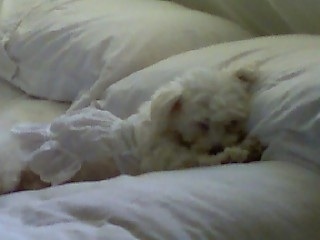
Bella, the 7-pound Malti-pom, "She's very quiet, and refuses to sleep at the end of the bed, she wants her head on the pillow, and her body under the covers right in between us!"
Large and medium size dogs are less likely to be allowed to sleep at the top of the bed next to a person's pillow. There simply is not room for both human and a large dog. If a large dog is allowed on the bed, they will often be told to sleep at the foot of the bed. Small dogs are more likely to be allowed to sleep right on a human's pillow. In the dog world, the pack leader sleeps in the highest (height wise) most comfortable place. And for those very tiny dogs who cannot jump on the bed themselves, they get to bark and TELL THE HUMAN when to put them on the bed and when to take them back off the bed. In a dog's mind only the pack leader tells others what to do. It is not necessarily a bad thing to allow your dog to be on your bed, so long as YOU are deciding when they can get on the bed and when they need to get down. Just keep in mind in the dog world, the pack leader sleeps in the most comfortable spot; so do not allow your dog to push you out of your spot. Your dog needs to lie around YOU, not you around THEM.
The Yappy Trait
While some dogs have more of a tendency to get yappy. The yappy traits have everything to do with the way they are treated by the owner. For instance, if the dog lacks a pack leader and feels THEY are the pack leader they may become yappy every time you leave them alone. Or become yappy as they try to get YOU to follow THEIR commands.
If you fall into the "Small Dog Syndrome" and allow a dog to take over the home, they will tend to be more yappy. Small dogs who see their humans as 100% pack leader and are told to hush when they do bark, get daily walks and are content with themselves are less likely to be little yappers.
The Nervous Trait
When a dog appears scared, nervous, stressed, or otherwise upset in any way, we humans tend to pet them, stroke their coat, and talk to them in a soothing manner. We tell them everything is ok. We do this with both large and small dogs, but we tend to do it even more with the smaller dogs. We pick up the little dog and cuddle them every time they look upset. We humans feel good about giving this type of comfort. It's human nature and our little dogs are our babies.
This type of reassurance works on humans, it's what humans do and we understand this type of comfort. However, when the canine animal is in an unstable state of mind and is given a human consolation (treated like a human) it intensifies the dog's state (stress, fear, nervousness etc.). In the dog world when a dog is in an unstable state and you try to reassure them by giving affection, the dog sees you as being in a weaker state than their own. The canine species can read human energy. They read sympathy as weak energy. With their primal instinct to have order in their pack, it is very disturbing for a dog in a weak state of mind to be surrounded by other weak pack members. At these times there is no pack leader and chaos is present as no one is providing direction. The same is true in ALL human societies. That is why leaders are elected or allowed to be in place. It intensifies the dog's instability, sometimes to the point where the dog, in their already unstable state, tries to be your pack leader. In the dog's mind you are now weaker than they are, which instinctually puts the dog in a higher alpha position than you. Instinct tells a dog that the stronger member is higher in the pack order. This ensures the packs survival. You need to give off a stronger, more stable energy that the dog can feed from.
Many little dogs suffer from instability due to their likelihood of being babied and over protected. When large dogs are upset, since we cannot pick them up, they are less likely to be treated in this manner.
Separation Anxiety
Dogs who believe they are the pack leader often develop separation anxiety. Followers are not allowed to leave the pack leader but pack leaders can leave the followers.
List of dominate behaviors which can occur in dogs (This list is not yet complete)
Besides the obvious guarding, growling and biting many dogs display a variety of dominant behaviors that commonly go unrecognized by their humans. Dogs very rarely display the highest level of dominance overnight. There are usually signs leading up to it over the years and dominate alpha dogs do not always growl and bite. If the owners are giving the dog what they want there sometimes is no reason for the dog to growl or bite unless they are challenged. Dogs understand that they exist in a human world. After all, who gives them food and opens the door for them to go potty? When humans perform these tasks on demand from the dog though, why wouldn't the dog think they're the leader? It is easy for dogs to get the impression they are alpha in their pack. Since many canine alpha behaviors are not acceptable in human society, for example biting being one of the alpha communication tactics it is important for humans to remain the leaders over their dogs.
Below are some common behaviors dogs display when they believe they are above humans. Keep in mind that a dog does not have to display all of these behaviors to be in a dominant frame of mind. Sometimes an alpha dog will only display a few of the behaviors and at random times, depending on what the dog decides they feel like doing at any given moment. Smarter dogs tend to challenge the pack order more then dogs of average or below average intelligence.
Stubbornness
Demanding
Pushiness
Begging
Pushing a toy into you in order to get you to play with them.
Nudging to be pet.
Sitting in high places looking down on everything.
Barking or whining at humans which many owners consider "talking" (without a command to do so).
Jumping or putting their paws on humans without a command to do so.
Persistence about going in and out doorways before humans.
Persistence about walking in front of humans while on a lead.
Not listening to known commands.
Dislikes people touching their food.
Standing proud on a human lap.
Persistence about being on top, be it a lap or stepping on your foot.
Persistence about where they sleep (i.e. on your pillow).
Annoyance if disturbed while sleeping.
Likes to sleep on top of their humans.
Licking (giving kisses) in a determined and focused manner.
Carrying themselves with a proud gait, head held high.
Not liking to be left alone and getting overly excited upon the humans return. (See Separation Anxiety in Dogs)
Conclusion
The bottom line is; small dogs are no different than large dogs. What gives them their different temperaments is that humans treat them differently. We over protect them and treat them like babies. Things we do not allow large dogs to do which are common pack leader issues because of the dogs size are addressed. These are issues all dogs need to have addressed, yet the smaller dogs tend to not get this discipline.
If you are unsure how to gain control back from your dog, or if you think you are at risk of being bitten, please hire a professional to help you before you give your dog to a shelter. This commonly sentences them to Death Row. This will (or at least should) cause you to feel remorse and guilt that you will have to deal with (to varying degrees) for the rest of your life.
To learn more about dog psychology and what makes a dog tick, we strongly suggest Cesar Millan DVD's and or Cesar Millan Books to every dog owner, from Chihuahua to Pit Bull
. An excellent guide to
Saturday, 6 June 2009
Speaking Dog. What's your dog saying?
One of the most common mistakes owners can make with their dogs is to misread what the dog is saying into something completely different. We humans do it all of the time. The dog's body language says one thing, and we interpret it into something completely different basing our assumption on what we ourselves are feeling. When in reality dogs see and read the world much different than we humans. If we humans better understood our dogs we could prevent many dog bites and other behavioral issues.
Dogs and Hugs
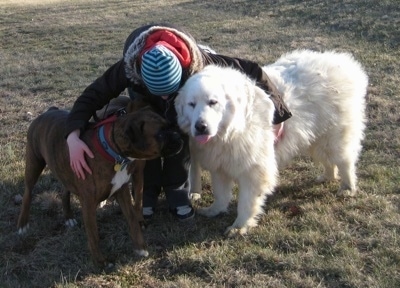
For example lets take a simple act of a hug. To humans a hug means love and affection. When a human receives a welcomed hug from a loved one it makes us feel good inside.
But just what does a hug mean to a dog? Humans are always hugging their dogs and when we do we are giving the dog affection and sharing our love. However what most humans do not realize is to a dog a hug is not affection at all. To a dog a hug symbolizes a social status ranking representing dominance and an invasion of space. Lower members of the pack give space to the higher members as a show of respect. The position of the body is also meaningful to a dog. The one on top represents a higher status ranking. Therefore when you bend down and wrap your arms around a dog you are not only on top, but you are in their space.
Keeping this logic in mind, it makes total sense to not run up and hug a strange dog. Many children are bit every day by hugging dogs and if you look at it from the dogs perspective who would blame them? A stranger comes running over asserting dominance on a dog they have just met and the dog's reaction is to communicate to this being that they do not wish to be dominated. Unlike horses and deer who are "flight animals", a dog is a "fight animal" and will communicate his displeasure with a growl, and or a snap or bite.
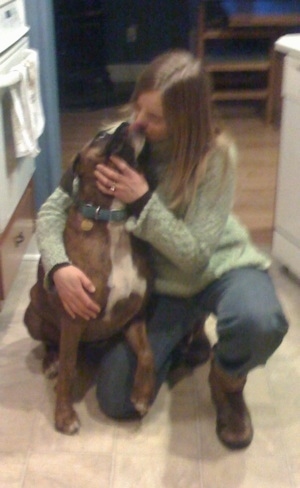
That being said, it is not bad to hug a dog that is familiar with you if the dog is calm and in a submissive state of mind, so long as you are hugging them at a time when you are relaxed and happy. As a matter of fact the emotional sensation it gives the humans to hug can be felt by the dog, and that energy radiating from the humans can be very calming to the dog. Not because he is enjoying the hug, but because he is enjoying the calm he feels coming from you.
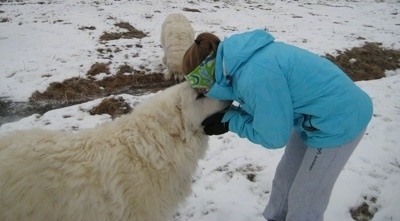
I watched a little girl come running over to a dog, giving the dog a huge hug. The little girl was overjoyed. You could tell she just loved dogs. I watched the dog's face. The dog's eyes were wide and he went somewhat stiff, as he turned his head up toward the being who was wrapping his arms around him. I saw him flick his tongue in a nervous way. While this dog did not bite this child it was clear the dog was not enjoying it. Had the child been hugging a more dominate dog the dog just may have snapped at her.
I then watched the child hug a second dog. The second dog was Bruno. Bruno lowered his head and allowed himself to be hugged. He, like the first dog, also flicked his tongue, but in a different way. His tongue came all the way out and back in as he tried to lick the child. His lick was submissive where as the first dog's lick was nervous. Bruno enjoyed the attention. He is just about as submissive as they come and enjoys any attention from any human he can get.
When you allow your children to hug strange dogs you are taking a gamble in the dog's reaction. Not even the owner can always predict what the dog's reaction will be. The proper way to greet a dog is to turn your body sideways, no eye to eye contact and allow the dog to smell you. That is greeting a dog in dog language in a non-confrontational way.
Human Interpretation
Here is another good example of how we humans assume our dogs have the same emotions and feelings as we have and put our own interpretations into a dogs reactions. This is a YouTube clip of Bonnie Hunt and her interpretation of this baby crawling over to the dog. Notice the emotion the clip draws from the human. The talk show host assumes the dog was bonding and acknowledging in a heart felt loving kind of way. The host is so moved by what is in that clip that she looks like she could cry. Overwhelmed with joy about what she believes is an emotional tie between the baby and the dog.
A lot of humans are going to watch this clip and attach their own emotions to what THEY interpreted the dog was feeling at the time the dog touched the baby back with his paw. But what is the dog really communicating? Is he overwhelmed with emotion because the cute little baby crawled over and connected with him? No, not at all. When the baby first crawled over and touched the dog's paw the dog sat up and looked to see what was touching his foot. Saw it was the baby. The dog then seeing it was the baby submitted by laying his head down. When the baby touched the dog's paw this submissive Boxer saw it as a game and was playing with the baby. But there was no heart felt emotional tie in the dog's mind like the announcer read into it. There was no strong feeling of affection felt by the dog when the baby touched his paw. The dog did not touch the baby back to show his reciprocated love. It was just a gentle game. The dog was playing. One thing we can all agree on is this clip is adorable and that Boxer is a very good dog.
When Bruno is laying down and I start to touch his feet he'll do the same. Start to move his feet because he thinks its a game we are playing. Not because he is emotionally connecting with my touch. Here is a clip where I touch Bruno's foot with a clothes hanger. Bruno sits up. When I touch his front foot he paws at it much like the Boxer who put his paw on the baby's hand.
Space
I often hear people state that when they correct their dog for a bad behavior the dog sulks, leaves the room or turns his head because the dog is "upset". The humans interpret this behavior as the dog's feelings are hurt. They feel bad and believe they need to go and "make up" with the dog.
What is the dog really saying? If you correct your dog and he turns his head or leaves the room he is giving in to you and accepting you as his leader. Giving space or turning away from direct eye contact are submissive behaviors. When humans try and "make up" with a dog after the dog has given in to you, it sends confusing mixed signals to the dog.
These examples are just the tip of the iceberg. Humans misread their dogs on a daily basis and on a wide scale of issues. I can't even imagine what it is like for a dog to be constantly misread and how confusing it must be for them. Most dogs do not wish to be the leaders, do not wish to run the show. They only wish to be secure with their pack and clearly know their status. However, they will take over when they do not see the humans as stronger then themselves. We humans would do our dogs a huge favor by trying to better understand them rather than just assume they are just like us.
and or Cesar Millan Books to every dog owner, from Chihuahua to Pit Bull
. An excellent guide to
Written by Wow Dogs
Thursday, 4 June 2009
Choosing The Perfect Puppy Names - Find A Special Name For Your Special Puppy
So you're looking for a cool puppy name for your cheeky new housemate. No doubt you are searching for some inspiration and ideas so you can come up with a puppy name that is unique and befitting of your new little friend. You want a name that perfectly suits your individual dog and does him/her absolute justice.
There are so many things to consider and take care of when preparing for the arrival of a new puppy. First you have to choose the most suitable breed of dog, then find a reputable breeder and most importantly pick out the little puppy who will become your lifelong companion. It doesn't stop there... Once home you will need to provide all the basic puppy supplies, socializing your puppy to the world becomes an urgent priority and then of course you will need to get stuck into some early puppy training.
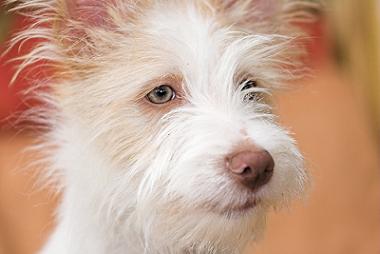
"The puppy name you decide on says as
much about you as it does about your dog."
One of your most important (and fun!) decisions when you get a new puppy is to come up with a funky name - but where do you begin to search for that perfect puppy name?
A popular way to find a name for your puppy, that is both appropriate and memorable, is to look through the extensive online databases listed below. These are sure to give you some great puppy name ideas and maybe even some inspiration to make up your own.
Puppy Names - Check Out These Huge Databases Of Dog Names
Female Dog Names
Click on the link above for a huge range of puppy naming ideas. You'll find heaps of cool female dog names, cute dog names, all the popular dog names, girl dog names and lots more! You can't help but be inspired by these great resources!
Male Dog Names
Click on the link above for heaps of ideas for male puppy names. You'll find a huge resource of popular boy dog names, favorite puppy names and unique boy dog names. Best of luck finding a brilliant name for your male puppy.
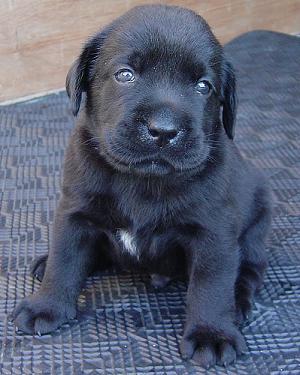
Regardless of which puppy name you come up with, your pup will need plenty of guidance, socialization and puppy training in order to become a trusted and well behaved member of the family. To help guide you through the various puppy training stages I recommend you follow this comprehensive puppy training resource - Secrets To Dog Training. This package will take you step by step through the puppy house training process, preventing problem behaviors and right through to advanced obedience training commands.
Some other pages you may be interested in:
How To Choose A Dog Breed - Choose a puppy that is just right for you and your lifestyle.
Choosing A Puppy Out Of The Litter - Things to consider when selecting your little puppy out of a litter.
How To Train Your Puppy - Covers all the basic puppy training issues.
Dog Supplies - Online Store - Need some dog supplies for your new puppy?
Perfect puppy name












